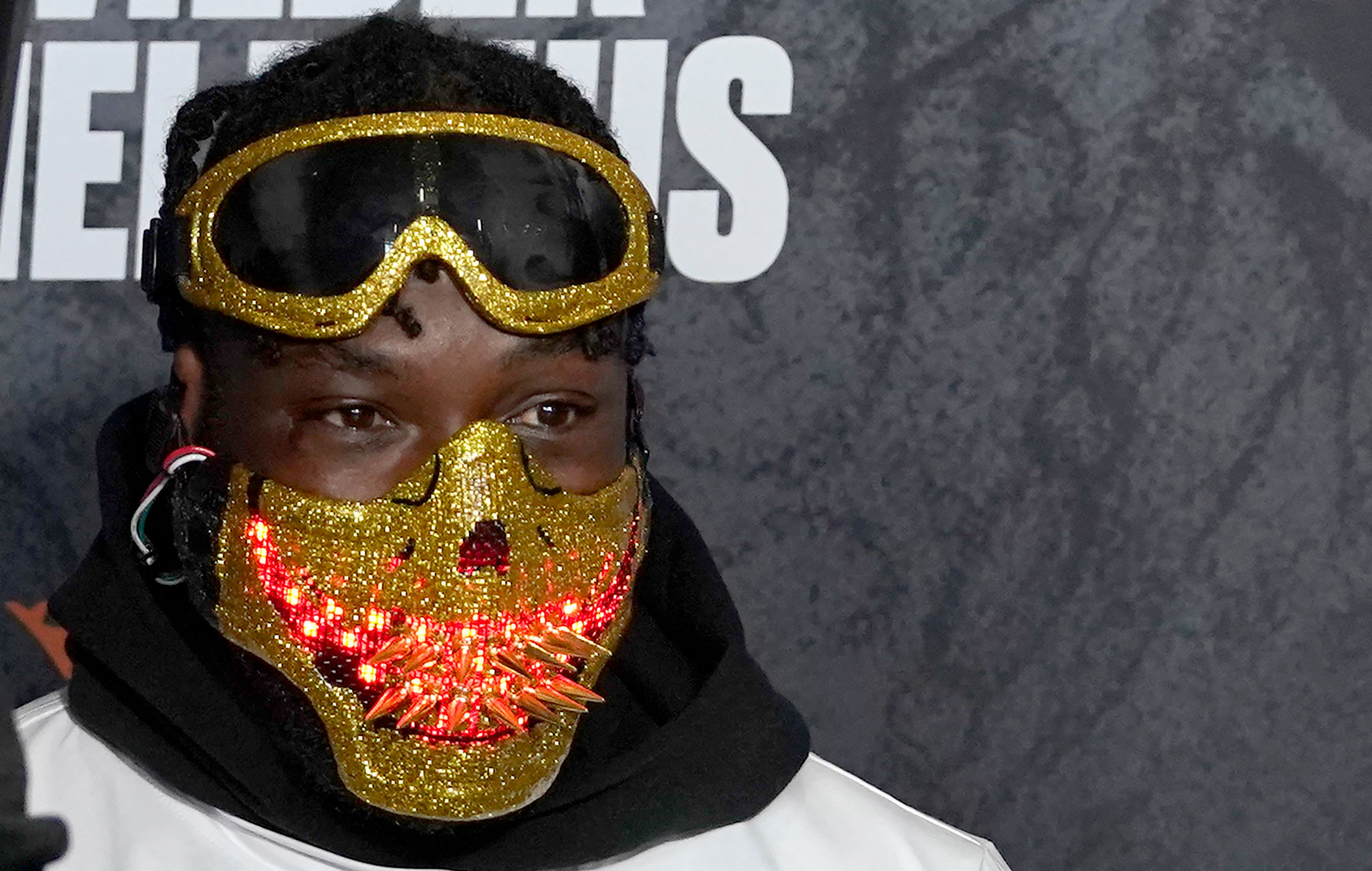DEONTAY WILDER has weighed in almost two stone lighter for tomorrow’s fight with Robert Helenius than a year ago against Tyson Fury.
The Bronze Bomber, 36, steps back into the ring for the first time since his trilogy bout with the Gypsy King.
Deontay Wilder has shredded the extra weight for his boxing return
That night, he weighed in at a career-high 17st – or 238lb – as he unsuccessfully tried to wrestle back the WBC world heavyweight title.
But Wilder, who takes on Helenius in New York, makes his comeback as a slimmed-down fighter.
The Alabama boxer tipped the scales today at 15st4lb 8oz – 214.5lb – a far more natural weight for the heavy-hitter.
As usual for Wilder, he will be significantly lighter than his opponent with Helenius carrying 18st 1lb.
Speaking during his training camp, the 42-2-1 man said: “We gained a lot of weight the last fight. I felt a little sluggish, a little heavy
“And, you know, I was interested in seeing my body frame in a certain weight as well.
“But at this moment in time, I go back to what I’m used to and what’s comfortable to me and what’s comfortable with my body frame.
“And that’s gonna be around maybe 220lbs or maybe under.”
 Wilder vs Helenius: Ring walk time, TV channel, live stream and undercard info for huge return
Wilder vs Helenius: Ring walk time, TV channel, live stream and undercard info for huge return
Should Wilder win his first fight since November 2019, he would be back in contention among the top heavyweights in the world.
And he is already eyeing up a blockbuster bout with Ukrainian hero Oleksandr Usyk – pipping rival Fury to the unification showdown.
Usyk is understood to have made clear he is open to a fight with Wilder.
Wilder, who also wants to box Anthony Joshua, said: “I asked my guys if Usyk is a man of his word and they confirmed that he is.
“So I am going to hold him to his word and we will see. Hopefully, he is a man of his word.
“In this division, you’re only one win from a title shot.”
 Robert Helenius came in almost three stone heavier than his opponent
Robert Helenius came in almost three stone heavier than his opponent

He wore another of his famous masks paired with matching goggles
Frequently Asked Questions
How long does it take for you to learn boxing
Boxing takes approximately 3 months to learn. This includes learning the basics, such as footwork, stance, and balance. Boxing isn’t just about throwing punches. You also need to learn how to block and dodge attacks.
How long does it take for boxers to train each day?
Boxing trainers often train at least 4 hours per day. They also study boxing techniques and learn new moves. Boxers can spar up to 10 times per week.
How to defend yourself
Always protect your head when being attacked. Avoid getting punched. To do this, you will need to learn how to prevent an incoming punch. Here are the steps:
- Keep your shoulders square and tall.
- Keep your elbows close to your sides.
- Your forearm can block the punch coming from your opponent.
- Counterattack immediately.
- Continue blocking until your attacker runs off.
- Never give up on your defense.
Do I have to fight in order to train boxing?
Fighting is the only way to train boxing. It takes hard work to improve your boxing technique. It is possible to improve your boxing technique.
A good fight will help you improve your boxing technique. It is important to observe their movements, their defenses, and how well they use punches. Next, try to copy their moves.
The next step is to spar with another boxer. This is where you will see if your boxing technique has improved. You will also be able to see how fast you punch, how strong your punches are, and how well it blocks incoming punches when sparring.
You’ll also need to practice your boxing skills through drills. You will improve with practice so be patient and persevering.
What are the best ways to learn boxing defense from home?
Boxing is among the oldest forms of martial art known to man. Boxing can also be considered to one of hardest sports to perform. You can’t just punch someone across the face and make him go away. You need to know how you can defend yourself against punches or kicks.
Locate a boxing club near you. Once you have found a suitable place to train you’ll need some gloves or headgear. Gloves protect you hands while the helmet protects your head. You’ll also need to wear shorts and a T-shirt.
Once you’ve gathered all your equipment, it’s time for you to start warming up. Start slow and build up speed. You can then go to the mat and spar with another fighter when you feel ready. If you fail, don’t be discouraged. Don’t worry if you miss. Just keep trying until it works.
Statistics
- It is just like normal sparring with a partner, but you want to throw punches at 75% of your normal speed. (wikihow.com)
- You want to be running at roughly 75-80% of your top speed..5 mile slow, easy recovery jog at the end.[6]X Research source 2Mix in long runs, shadow boxing, and short sprints on non-interval days. (wikihow.com)
External Links
expertboxing.com
amazon.com
- Amazon.com: Ringside Diablo Wrestling Boxing Shoes : Clothing, Shoes & Jewelry
- Amazon.com : Sanabul Boxing Handwraps Elastic 180 inch Red : Sports & Outdoors
How To
Here are the Basic Skills of Boxing
How to box effectively
Boxing has become a very popular sport. It involves two people who attempt to knock each other out of their heads. Different countries have different rules. There are three types generally of boxing: Amateur (Professional) and Olympic (Olympic).
Amateur boxing may be done at school, college, and university. This boxing style includes sparring sessions without protection, using padded gloves. Usually amateur boxing competitions consist of three rounds of five minutes each. There are many styles of amateur boxing such as Kickboxing or Muay Thai, Taekwondo and Karate, Judo and Wrestling, among others.
Boxing is typically practiced in clubs, stadiums or gyms. They are protected by protective equipment like a mouthpiece, nose protector, shinguards, elbow pads and knee pads, waist belt, and groin protection. Professional boxing competitions have six rounds that last four minutes each. There are several different styles of professional boxing including Boxing, MMA (Mixed Martial Arts), Kickboxing, Muay Thai, Taekwondo and others.
Olympic boxing is done at the Olympics. Boxers are required to wear international standards-compliant protective gear. The competition lasts for eight rounds, each lasting three minutes. Olympic boxing has only two styles, Light Flyweight vs Heavyweight.
Boxing’s fundamental skills are:
- Punching techniques
- Techniques for protecting yourself
- Footwork
- Stance
- Movement of the body
- Defense
- Combination
- Rotation
- Spare parts
Punching Techniques
There are seven types. Each punch comes with its own technique. Some punches require more force than others. A strong uppercut for example requires a lot of force. On the contrary, a straight punch takes less power but is faster than most punches.
There are also various punching combinations. These are combinations made up of several punches that can be used together to achieve one goal. An entire combination could have several parts. A left hook followed with a right-cross will cause injury to the opponent’s jaw.
Guard Techniques
Boxers protect themselves by protecting their bodies. He does so by using his arms, elbows and hands as well as his knees, knees and legs.
Legs
Boxers must use their legs to defend themselves against kicks. When he receives a kick, he raises his leg and moves away from the attacker. If the attacker is coming from the front, he will bend at the knees to avoid getting kicked on either side. He will block the kick with his foot if the attack is coming from behind.
Elbows
Because they inflict pain, elbow strikes can be very effective. An elbow strike can be delivered directly or indirectly. Directly refers to hitting your opponent with the forearm, while indirect means you hit him using another part of your arms.
Hands
Boxers use the power of their hands to block any incoming blows. Boxers raise their fists to block incoming blows and then move in the direction of the attacker’s attack. Then, they touch the attacker’s hand.
Knees
Boxers should bend their knees when receiving blows to the abdomen, stomach, or chest. Knee strikes can be used to defend yourself.
Feet
If he is being attacked, a boxer must take a step back and counter-attack. This way, he can gain distance between himself and his opponent. In addition, when delivering a counter-attack, a boxer should keep his balance.
Stances
Boxing effectively requires a boxer to have a good stance. The way he defends himself will be determined by his stance. It defines where he faces his opponent and how he positions his body. There are many positions that boxers can adopt. Here are some of the more popular ones:
- Low stance
- High stance
- Southpaw stance
- Western stance
The Body Movement
To win a fight, a fighter must move around the opponent. This requires changing your position, speed, and rhythm.
Rotation
Rotating his arm to increase the puncher’s reach is a key part of boxing. The rotation is done at different speeds depending on the type of punch.
Combinations
Timing of each punch is crucial to the effectiveness of a combination. A combination is good if it starts with a strong punch then ends with a weaker one.
Spare parts
Sparring is a training session that improves boxing skills. Boxers learn to train their mind and bodies during sparring sessions. Sparring is a way to learn how to fight without getting hurt.
To sum it all, boxing requires patience and dedication. You need to train hard and long in order to become a better boxer.

